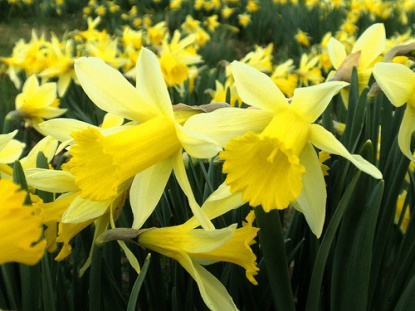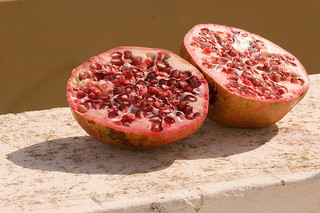Classification And Phylogeny
Where does the Narcissus
pseudonarcissus species fit in?
Domain: Eukarya
Kingdom: Plantae
Phylum: Magnoliophyta
Class: Liliopsida
Order: Liliales
Family: Amaryllidaceae
Genus: Narcissus
Species: Narcissus pseudonarcissus
In English, Narcissus pseudonarcissus means wild daffodil. The word "narcissus" stems from the Greek word "narkao," meaning narcotic or to be numb. "Pseudonarcissus" continues with the Latin root word "pseudo," meaning "seeming to be" and "narcissus" again, referring to a narcotic or numb sensation. All in all, Narcissus pseudonarcissus translates from ancient Greek and Latin to mean "narcotic seeming-to-be narcotic." Ancient Greeks believed that the scent of narcissus flowers was evil and capable of inflicting headaches, disorientation, loss of mental stability, and as a final result, death. Luckily, smelling daffodils really does not have any adverse effects, no more than sniffing any other flowering plant.
The daffodil received its common name in an interesting manner. Many people believe that "daffodil" is a derivative of the words "daffodily" and "affodily," which refer to the asphodel plant, since daffodils were considered identical to asphodels. These associations are mentioned in texts by the ancient Greeks. In England and the surrounding islands, there are many names for the daffodil, including "cowslip," "Easter lily," "lenty cups," and "yellow maidens." The names for this plant vary by region, but "wild daffodil" is the most common name used.
 Domain: Eukarya
Domain: Eukarya
Daffodils are classified into the domain Eukarya for several
reasons. All members of Eukarya have membrane-bound
organelles, and only eukaryotic cells. Inside these
cells, eukaryotic organisms have multiple linear
chromosomes. Most species of eukaryotes are
multicellular, and experience sexual reproduction.
In daffodils, a major distinction that identifies it
as a member of domain Eukarya is that its cell walls
are made up of cellulose, unlike bacteria, which
have peptidoglycan in their cell walls. Other
organisms are included in domain Eukarya as well,
including examples such as the
damselfly or the
faucet snail. To learn how Narcissus
pseudonarcissus depends on other eukaryotic
organisms, visit the
interactions page.
Kingdom: Plantae
The kingdom Plantae is known for
characterizing organisms that all share the common
traits seen in plants across the world. For example,
all organisms in this kingdom, daffodils included,
are known to be multicellular, eukaryotic, and
autotrophic. Autotrophs are organisms that produce
their own food, instead of relying on outside
sources for nutrition. Daffodils are also sorted
into this kingdom because they contain chloroplasts,
which utilize chlorophyll to go through the process
of photosynthesis. Lots of other organisms depend on
photosynthesis, such as
peppermint or
tobacco.
Phylum: Magnoliophyta
Organisms found in the phylum Magniolophyta are commonly
referred to as flowering plants. It is simple to
imagine why daffodils are identified as part of this
distinct phylum... They have flowers! Members of
this phylum are also known scientifically as
angiosperms, meaning that they have unique
reproduction in which their fruits protects their
seeds, and flowers permit the transfer of pollen
between organisms. In daffodils, the flowers are a
bright and cheerful yellow color. Other organisms
that fall into this category include the
pomegranate
or the
common blue violet.
Class: Liliopsida
The class Liliopsida is also known as the monocotyledon
class. What this means is that organisms in this
class are all seed plants. These plants give rise to
a specific kind of embryo, one that has a single
cotyledon. A cotyledon is one of the first leaves
developed by the plant, which serves as food for the
embryo as it grows. Another specific trait
describing all members of this class is that the
leaves of the plant have parallel veins. Some other
examples of class Liliopsida members are the
moth orchid or
flat-leafed vanilla.
Order: Liliales
Organisms that belong to the class Liliales share several
distinct characteristics, which are all demonstrated
by Narcissus pseudonarcissus. These
flowering monocots all grow from bulbs or corms,
which are specific underground stems. In these
bulbs, they can store food during the winter. Most
examples of organisms in this class exhibit leaves
with linear, longitudinal veins. All of these plants
are perennial, and the daffodil is too. Other
organisms in this order include the tulip and the
North American wildflower trillium.
Family: Amaryllidaceae
This family is recognized for its strap-shaped leaves, which
all grow near the base of the stem, as can be viewed
in the species Narcissus pseudonarcissus.
The petals of the organisms in the family
Amaryllidaceae are displayed in multiples of three,
with three sepals behind them. Daffodils also follow
this pattern of petal organization. Other common
plants in the family Amaryllidaceae are the
amaryllis and the spider lily.
Genus: Narcissus
The genus Narcissus is the genus to which all
daffodil species belong, including jonquils as well
as the daffodils considered to be common today.
These organisms all are resilient plants, and flower
in the springtime after a designated cold period.
All Narcissus plants grow from a brown,
sphere-shaped bulb, and have leafless stems as they
mature. Each flower has a cup-shaped structure in
the center, called a corona. Narcissus
pseudonarcissus is known for its prominent,
beautiful corona. Some other common species of
Narcissus plants are the jonquil and the
angel's tears plant.
Species: Narcissus pseudonarcissus
This certain species of
daffodil is identified by its pale yellow flowers,
and a bright trumpeted corona in the center.
Narcissus pseudonarcissus is known for its
origin in western Europe, and its ability to
flourish in a variety of habitats. Its leaves are a
distinctive grey-green color.
The following diagram is a phylogenetic tree based on morphological features of Narcissus pseudonarcissus. It demonstrates where the wild daffodil fits into each category of classification from domain to order. By following this phylogeny, you can easily distinguish which domain, supergroup, kingdom, phylum, class, and order the wild daffodil belongs to. Its closest relatives in this phylogeny are the other orders of class Monocotyledones. Other species belonging to class Monocotyledones (also called Liliopsida) include saffron, wild rice, and the saw palmetto.
The next diagram demonstrates the further phylogeny of Narcissus pseudonarcissus, down to the species level. This phylogenetic tree is also based on the overall morphology of the plant. It begins with the order Liliales, which is what the final classification category was for the previous diagram. This diagram shows that some of the daffodil's closest relatives are Narcissus tazetta, Narcissus poeticus, and Narcissus jonquila, also known as the jonquil. There are over 50 individual species belonging to the genus Narcissus, therefore I was not able to acknowledge all of them in the diagram below.
Follow this link to revisit the homepage.
~ Learn about
the fascinating habitat of the wild daffodil. ~

